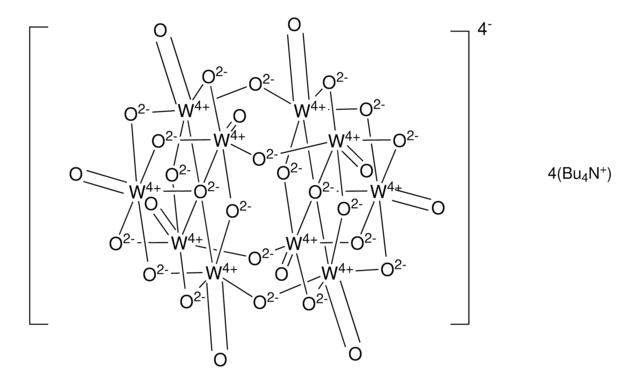224758
Tris(2,2′-bipyridyl)dichlororuthenium(II) hexahydrate
powder
Synonyme(s) :
Ru(BPY)3, Ruthenium-tris(2,2′-bipyridyl) dichloride, Tris(2,2′-bipyridyl)ruthenium(II) chloride hexahydrate
About This Item
Produits recommandés
Forme
powder
Pertinence de la réaction
core: ruthenium
reagent type: catalyst
Capacité de réaction
reaction type: Photocatalysis
Pf
>300 °C (lit.)
Activation du photocatalyseur
450 nm
Chaîne SMILES
[H]O[H].[H]O[H].[H]O[H].[H]O[H].[H]O[H].[H]O[H].Cl[Ru]Cl.c1ccc(nc1)-c2ccccn2.c3ccc(nc3)-c4ccccn4.c5ccc(nc5)-c6ccccn6
InChI
1S/3C10H8N2.2ClH.6H2O.Ru/c3*1-3-7-11-9(5-1)10-6-2-4-8-12-10;;;;;;;;;/h3*1-8H;2*1H;6*1H2;/q;;;;;;;;;;;+2/p-2
Clé InChI
WHELTKFSBJNBMQ-UHFFFAOYSA-L
Vous recherchez des produits similaires ? Visite Guide de comparaison des produits
Description générale
Application
- Used in the synthesis of hybrid catalysts which are used in oxidase based biosensors.
- Used as a luminophore for multiplexed signalling in bio analysis.
- Used in oxygen assesment in living cells.
Product can be used with our line of photoreactors: Including Penn PhD (Z744035) & SynLED 2.0 (Z744080)
Produit(s) apparenté(s)
Code de la classe de stockage
11 - Combustible Solids
Classe de danger pour l'eau (WGK)
WGK 3
Point d'éclair (°F)
Not applicable
Point d'éclair (°C)
Not applicable
Équipement de protection individuelle
Eyeshields, Gloves, type N95 (US)
Certificats d'analyse (COA)
Recherchez un Certificats d'analyse (COA) en saisissant le numéro de lot du produit. Les numéros de lot figurent sur l'étiquette du produit après les mots "Lot" ou "Batch".
Déjà en possession de ce produit ?
Retrouvez la documentation relative aux produits que vous avez récemment achetés dans la Bibliothèque de documents.
Les clients ont également consulté
Electrogenerated Chemiluminescence Sensing
Contenu apparenté
One major theme of research in the Yoon lab is the development of unique chemical transformations enabled by visible light photochemistry. A variety of transition metal photocatalysts responsive to visible light are known, and the Yoon lab has shown that their well understood photochemistry can be coupled to cycloadditions, arene oxidations, amine functionalizations, and thiol-ene reactions, among others.
Research in the Stephenson lab focuses upon the development of new chemical methods which enable the activation of chemical bonds under mild reaction conditions.
Notre équipe de scientifiques dispose d'une expérience dans tous les secteurs de la recherche, notamment en sciences de la vie, science des matériaux, synthèse chimique, chromatographie, analyse et dans de nombreux autres domaines..
Contacter notre Service technique




![[Ru(phen)3]Cl2 ≥95%](/deepweb/assets/sigmaaldrich/product/structures/955/596/46f63eaa-39f8-4058-847d-cef0862ada92/640/46f63eaa-39f8-4058-847d-cef0862ada92.png)
2 ≥95%](/deepweb/assets/sigmaaldrich/product/structures/190/371/c5efe61d-383f-4364-90c6-1912d88674f3/640/c5efe61d-383f-4364-90c6-1912d88674f3.png)

![[Ru(bpz)3][PF6]2 95%](/deepweb/assets/sigmaaldrich/product/structures/317/925/f0ef928e-bbea-4535-abe6-dda0bc28d32a/640/f0ef928e-bbea-4535-abe6-dda0bc28d32a.png)


![[Ir(dtbbpy)(ppy)2]PF6](/deepweb/assets/sigmaaldrich/product/structures/158/329/2544d673-d267-4aa1-8f46-2652aad4bfa0/640/2544d673-d267-4aa1-8f46-2652aad4bfa0.png)
2 ≥95%](/deepweb/assets/sigmaaldrich/product/structures/238/198/d2398f4d-117e-4482-8d8b-80ae657f6ea1/640/d2398f4d-117e-4482-8d8b-80ae657f6ea1.png)